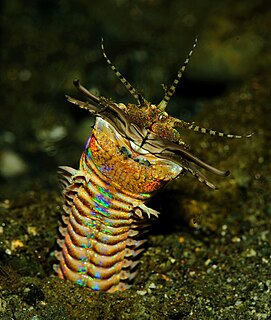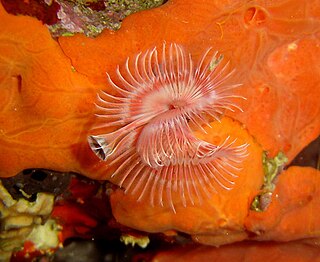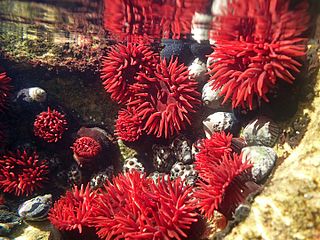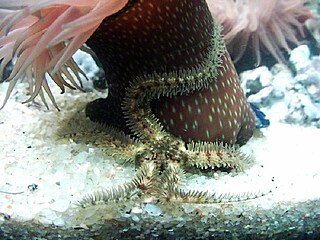
The sanderling is a small wading bird. The name derives from Old English sand-yrðling, "sand-ploughman". The genus name is from Ancient Greek kalidris or skalidris, a term used by Aristotle for some grey-coloured waterside birds. The specific, alba, is Latin for "white".

Fucus is a genus of brown algae found in the intertidal zones of rocky seashores almost throughout the world.

The intertidal zone, also known as the foreshore or seashore, is the area above water level at low tide and underwater at high tide. This area can include several types of habitats with various species of life, such as seastars, sea urchins, and many species of coral. Sometimes it is referred to as the littoral zone, although that can be defined as a wider region.

A rocky shore is an intertidal area of seacoasts where solid rock predominates. Rocky shores are biologically rich environments, and are a useful "natural laboratory" for studying intertidal ecology and other biological processes. Due to their high accessibility, they have been well studied for a long time and their species are well known.

Dicathais is a genus of predatory sea snails, marine gastropod molluscs in the family Muricidae, the rock snails. This genus is monotypic; the only species in it is Dicathais orbita, common name the white rock shell or cart-rut shell, found round the coasts of Australia and New Zealand.

Isobel Ida Bennett AO 1984 was one of Australia's best-known marine biologists. She assisted William John Dakin with research for his final book regarded by many as "the definitive guide on the intertidal zone, and a recommended source of information to divers". Following Dakin's death in 1950, she saw the book through to publication in 1952, and she continued to revise and reprint it with a complete revision in 1980 until 1992. In later editions, she was listed as a co-author, then first author. She also wrote nine other books, and was one of the first women to go south with the Australian National Antarctic Research Expeditions (ANARE).

Durvillaea willana is a large species of southern bull kelp endemic to New Zealand.

Eunice is a genus in the polychaete family Eunicidae. Individuals grow to a length of between 0.5 and 300 cm. Their bodies have multiple segments. They have two eyes and five tentacles. They have well-developed sense organs and relatively large brains. Their color is dark purple-brown to red-brown with a white ring at the fourth segment. They are found in oceans and seas around the world. They have an evertible proboscis with distinctive mouthparts, some of which comprise two rows of maxilliary plates in a radula-like fashion.

Hinea brasiliana, common name the yellow-coated clusterwink, is a species of small sea snail, a gastropod mollusc in the family Planaxidae. It is native to New Zealand and southeastern Australia where it is found in the littoral zone of rocky shores. It is one of only a few sea snail species able to bioluminesce.

Seashore wildlife habitats exist from the Tropics to the Arctic and Antarctic. Seashores and beaches provide varied habitats in different parts of the world, and even within the same beach. Phytoplankton is at the bottom of some food chains, while zooplankton and other organisms eat phytoplankton. Kelp is also autotrophic and at the bottom of many food chains. Coastal areas are stressed through rapid changes, for example due to tides.

Phragmatopoma californica, commonly known as the sandcastle worm, the honeycomb worm or the honeycomb tube worm, is a reef-forming marine polychaete worm belonging to the family Sabellarididae. It is dark brown in color with a crown of lavender tentacles and has a length of up to about 7.5 centimeters (3.0 in). The worm inhabits the Californian coast, from Sonoma County to northern Baja California.

Serpula is a genus of sessile, marine annelid tube worms that belongs to the family Serpulidae. Serpulid worms are very similar to tube worms of the closely related sabellid family, except that the former possess a cartilaginous operculum that occludes the entrance to their protective tube after the animal has withdrawn into it. The most distinctive feature of worms of the genus Serpula is their colorful fan-shaped "crown". The crown, used by these animals for respiration and alimentation, is the structure that is most commonly seen by scuba divers and other casual observers.

Bullia digitalis, the finger plough shell or plough snail, is a species of sea snail, a marine gastropod mollusk in the family Nassariidae, the Nassa mud snails or dog whelks.

A radiole is a heavily ciliated feather-like tentacle found in highly organized clusters on the crowns of Canalipalpata. Canalipalpata is an order of sessile marine polychaete worms consisting of 31 families. These benthic annelid tube worms employ radioles primarily for alimentation. While their primary role is to function as an organ for filter feeding, radioles also serve as respiratory organs. Because of their role in gas exchange, radioles are often referred to as "gills".

Cerithidea decollata, common name the truncated mangrove snail, is a species of sea snail, a marine gastropod mollusc in the family Potamididae.
Janua pagenstecheri is a species of marine polychaete. It is widely distributed around the British Isles and across north-western Europe, and has been described as "probably the commonest spirorbid in the world".

Marine habitats are habitats that support marine life. Marine life depends in some way on the saltwater that is in the sea. A habitat is an ecological or environmental area inhabited by one or more living species. The marine environment supports many kinds of these habitats. Marine habitats can be divided into coastal and open ocean habitats. Coastal habitats are found in the area that extends from as far as the tide comes in on the shoreline out to the edge of the continental shelf. Most marine life is found in coastal habitats, even though the shelf area occupies only seven percent of the total ocean area. Open ocean habitats are found in the deep ocean beyond the edge of the continental shelf.

Actinia tenebrosa, commonly named Waratah anemone, is the most common species of sea anemone found in the waters of eastern Australia and New Zealand. It is found relatively high on the seashore, in rock pools, and various cracks and shaded surfaces such as under rock overhangs in the intertidal zone.

Ophiothrix fragilis is a species of brittle star in the order Ophiurida. It is found around the coasts of western Europe and is known in Britain as the common brittle star. It is also found along the coast of South Africa where it is known as the hairy brittle star.

Galeolaria caespitosa is a worm of the family Serpulidae, casually referred to as Sydney coral when found in dense aggregations. It is an Australian inter-tidal tube worm which lives within a hard tube like shell, which prevents desiccation at high tide. Black feathery gills emerge when it is underwater for it to filter feed on plankton.



















